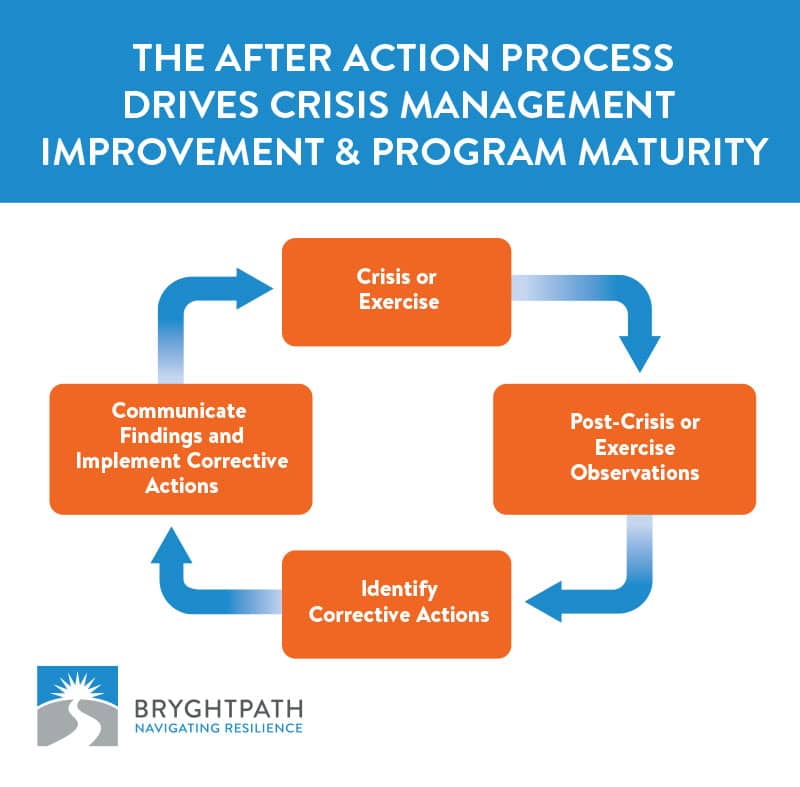As masks and PCR tests fade from the rearview mirror, we undertook a poll of how our clients fared in their pandemic crisis response. It revealed a pediatric dentist’s goody box of results.
From “wow, we did exceptionally well with our crisis response and I wouldn’t change a thing” (you know, like when you get that cool sticky octopus that crawls down the wall) to those that elicit a look of “meh, yay a tiny flower tattoo” and wishing we had a dug a little deeper into that cardboard treasure chest.
But when it comes to the crisis management after-action process, we dig deep, high, and low for all the sticky octopuses, tacky flower tattoos, and weird gizmos, gadgets, and kazoos in-between to inform our next crisis response.
That’s because we know that whatever their shape, flavor, or characterization, mistakes—when properly harnessed—are the backbone of innovation, growth, and profit.
And the key to leveraging our mistakes for good is in having a structured plan to observe, learn from, and improve upon them.
Bryghtpath has worked with dozens of Fortune 500 organizations and large non-profits to evaluate and improve their organizations’ crisis management and business continuity programs. Overwhelmingly, one of the most critical components of their success is having a straightforward process for capturing lessons learned in the aftermath of a crisis.
In the business continuity and crisis management world, we call this the “after-action process” or “lessons learned.”
Here, we discuss what the after-action process is all about, why your organization needs one, and the best steps you can take to get started.
What is an after-action process and why do you need one?
The after-action process, or sometimes called “lessons learned,” is a structured way to:
- Evaluate your organization’s performance during an actual crisis or crisis management exercise,
- Capture lessons learned, and
- Take action to update plans, processes, and protocols to improve your next crisis response.
It can seem like a complicated and unnecessary draw on your organizations’ resources and time after a crisis has already inconvenienced you. But if you want to avoid making the same costly mistakes the next time, it’s critical to have a structured process for improving how your organization responded to the crisis. The goal is to make original mistakes. Not the same ones over and over again.
Here’s a simple illustration of how the after-action process is structured around a basic process improvement model to incorporate lessons learned and improve an organization’s crisis response over time:

At Bryghtpath, we focus the after-action process on answering three simple questions:
- What went well during this process?
- What didn’t?
- What should we do differently next time?
Ideally, this information is gathered in an open, collaborative manner through a series of after-action meetings. During each meeting, lessons learned will be captured and documented along with action items for improvement. Then those learnings and appropriate corrective actions are disseminated throughout the organization to improve upon the crisis management process.
Let’s take a look at how the after-action process works in more detail.
What are the critical steps in the after-action process?
1. Before the incident
An essential but often overlooked first step in the after-action process is determining whether a formal after-action review is even needed. Your crisis management plan should include baseline parameters for determining when to conduct a full after-action review or keep it to a quick post-incident “hot wash” (which we discuss further below.)
Incidents that are relatively simple and have not resulted in a full crisis activation likely do not require an after-action process. More complex incidents, such as an active shooter situation, will most likely require a complete after-action process to be conducted.
2. Right after the incident—the “hot wash.”
In the immediate aftermath of a crisis, it’s helpful to briefly discuss how the crisis was handled. We call it the “hot wash.”
The primary goal of the hot wash is to get everyone’s recollections and reflections while events are fresh in people’s heads. If you wait a week or two to initiate your formal after-action review, important observations will likely be lost.
But why bother with a hot wash at all? Why not just get right to the after-action review?
In the immediacy of the response, everyone is exhausted, emotionally charged, and lacking the perspective that only time and rest can provide. The hot wash is the raw snapshot to tuck in your back pocket for later review when calmer and more rested heads prevail.
3. The After-Action Review
Despite memorializing your immediate impressions with the hotwash, we encourage our clients to begin formal after-action meetings within 7-10 days following a crisis. It’s important to capture lessons learned while they are still fresh in the participants’ minds.
Scheduling separate meetings or calls for each distinct audience can help encourage an open and collaborative environment for participants to share their experiences.
Example groups for separate after-action review meetings might include:
- Executive Leadership
- Corporate Crisis Management Team
- Local Leadership & Support Teams
The after-action meetings should be centered around an open discussion of these three key questions:
- What went well during this process?
- What did not go well?
- What should we do differently next time?
4. Reporting and communicating your findings
Your findings and action items from the after-action meetings should be memorialized in a written report that succinctly captures key observations, learnings, and next steps.
This can be done most simply by creating two columns; the first for observations and findings in critical areas and the second, for recommended actions based on those findings and observations.
For example, an incident might reveal problems with communications that negatively impact a crisis response. A recommended action might be prioritizing better centralizing stakeholder communications through organizational alignment efforts and developing communications messaging that can be easily accessed during a crisis.
It’s also important that each lesson learned and respective action item is assigned a responsible owner, due date, and relative priority for the organization. You should also include the typed raw notes from the after-action review meetings in an appendix to the report.
Once the after-action report is completed, it should be circulated to appropriate participants, executive leadership, and other stakeholders and also filed in your organization’s corporate records pertaining to crisis management.
5. What if the crisis is prolonged?
In a prolonged crisis, it can be helpful to conduct periodic abbreviated after-action reviews to glean from lessons learned and correct course where necessary. The frequency and depth of intermediary reviews will depend on the nature of the crisis and the organization’s needs. In walking our clients through the COVID pandemic, we found a six-month review cadence to work well for most large organizations.
Want to learn more about Crisis Management?
Our Ultimate Guide to Crisis Management contains everything you need to know about crisis management.
You’ll learn what it is, why it’s important for your organization, how to prepare for a crisis, how to respond when a crisis happens, and how to recover and learn from a crisis after it is over. We’ll also provide some perspective on where to learn more about crisis management.
How to get more out of your after-action review process
Leave feelings out of it
When preparing an after-action review process for our clients, we are sometimes asked why our after-action meeting templates don’t include any questions about how people felt about the crisis response?
We agree wholeheartedly that it’s important to provide your employees with the support they need to help them process the mental load of an ongoing or past crisis. But that’s not the focus of the after-action review process.
The after-action review should stay firmly centered on these key questions:
What things worked? What things didn’t? And what are we going to do about it?
People’s feelings about the crisis response are valid, but they have limited utility in the after-action review and often only complicate and slow the review process.
Avoid the blame game
It’s easy for the after-action process to turn into a blame game.
“If legal had done their job, none of this would have happened.”
“If IT had backed up our data to the cloud, we wouldn’t be in this pickle.”
But blame only serves to shut down the open flow of ideas and retrospection that is critical to a holistic and effective after-action review.
You should strive for an environment that encourages collaboration and openness during the after-action review process. Keep your questions focused on the what, rather than who, of what went wrong.
Don’t overcomplicate
One of the most common mistakes we see is that organizations try to overcomplicate the after-action review process. Many emergency management professionals are trained under guidelines established by bureaucratic behemoths like the Department of Homeland Security, who target their advice to national and regional scale incidents that demand a more searching and comprehensive review. But this approach is overwhelming and ineffective for the typical private sector or nonprofit business.
The after-action review process only needs to answer just three simple questions:
- What worked?
- What didn’t?
- What do we do differently, and how will we capture and track that?
In time, these simple and actionable steps will add up to exponential improvements in your crisis management program and leave you better prepared for the next crisis.
Want to work with us or learn more about Crisis Management?
Are you ready to get started with (or maybe uncomplicate) your crisis after-action review process? Need a whole lot more than a rockstar template?
- Get our After-Action Process & Templates from our Crisis Playbook product.
- Our proprietary Resiliency Diagnosis process is the perfect way to advance your crisis management, business continuity, and crisis communications program. Our thorough standards-based review culminates in a full report, maturity model scoring, and a clear set of recommendations for improvement.
- Our Crisis Management services help you rapidly implement and mature your program to ensure your organization is prepared for what lies ahead.
- Our Ultimate Guide to Crisis Management contains everything you need to know about Crisis Management
- Our Free Crisis Management 101 Introductory Course may help you with an introduction to the world of crisis management – and help prepare your organization for the next major crisis situation.
- Learn about our Free Resources, including articles, a resource library, white papers, reports, free introductory courses, webinars, and more.
- Set up an initial call with us to chat further about how we might be able to work together


 How to Choose a Crisis Management Consultant
How to Choose a Crisis Management Consultant